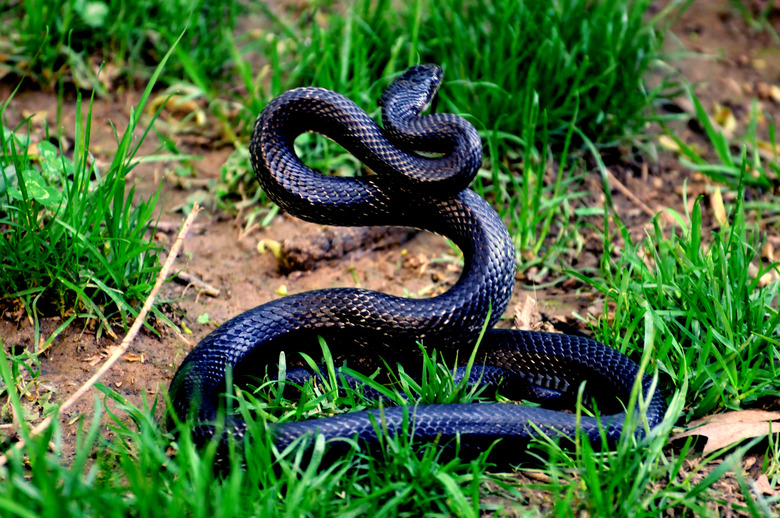How To Identify The Snakes Of New Jersey
Officially, New Jersey is home to 23 species of snake, but one of those, the queen snake, is likely locally extinct. So, it's highly unlikely you'll ever spot one of those. However you still have a good chance of identifying one of the 22 other species if you know what you look for. Each species has its own unique colors and markings.
TL;DR (Too Long; Didn't Read)
You can identify a snake in New Jersey by observing its color, markings and scales.
Snake Color
Snake Color
If the snake is plain black and shiny, for example, it may be a black rat snake (Elaphe obsoleta obsoleta) or a northern black racer (Coluber constrictor constrictor). The difference between these species is the body shape. The black rat snake has a flat belly and sides, a little like a loaf of bread, while the northern black racer has a slim, round body. Also, the northern black racer has a slightly lighter underside than back. The northern ringneck snake (Diadophis punctatus edwardsii) may also be black, although it may be brown or dark grey, and has a yellow ring around its neck and a yellow underside.
The rough green snake (Opheodrys aestivus) is light green with a white, yellow or pale green underside. The smooth green snake (Opheodrys vernalis) looks similar, but it is a much brighter shade of green.
Snake Markings
Snake Markings
Most New Jersey snakes have distinctive markings. For instance, the corn snake (Elaphe guttata guttata), also known as the red rat snake, is a state endangered species with a ground color of orange, brown or gray, with orange, red or brown blotches outlined in black running down the middle of its back. It has smaller blotches on its sides.
The eastern garter snake (Thamnophis sirtalis sirtalis) usually has an olive, brown or black ground color; yellow, brown or greenish lateral stripes; and a green or yellow belly with two rows of black spots. It may be mistaken for the eastern ribbon snake (Thamnophis sauritus sauritus), but the latter is more slender and its three side stripes are brighter yellow.
Only two New Jersey snakes are venomous: the northern copperhead (Agkistrodon contortix mokasen) and the timber rattlesnake (Crotalus horridus), another state endangered species. The northern copperhead has a coppery-red head and dark hourglass-shaped bands that are wider on its sides than its top. The timber rattlesnake has two color variations in New Jersey; the yellow variation has a yellow or brown ground color with black or dark brown V-shaped crossbands, and the black variation has the same crossband pattern hidden by black or dark brown pigment.
Snake Scales
Snake Scales
Snake scales are smooth (northern black racer, northern ringneck snake and smooth green snake) or keeled (rough green snake and timber rattlesnake). Smooth scales reflect the light and are smooth to the touch, while keeled scales have a ridge down the center and are rough to the touch. Sometimes, the scales are weakly keeled, such as on the black rat snake and corn snake. This means the ridge is less pronounced and the scales are not quite as rough.
Snake Scales
References
- The State of New Jersey: Black Rat Snake
- The State of New Jersey: Northern Black Racer
- The State of New Jersey: Northern Ringneck Snake
- The State of New Jersey: Rough Green Snake
- The State of New Jersey: Smooth Green Snake
- The State of New Jersey: Corn Snake
- The State of New Jersey: Eastern Garter Snake
- The State of New Jersey: Eastern Ribbon Snake
- The State of New Jersey: Northern Copperhead
- The State of New Jersey: Timber Rattlesnake
- Florida Museum: Color Patterns & Scales Structure
Cite This Article
MLA
Gillespie, Claire. "How To Identify The Snakes Of New Jersey" sciencing.com, https://www.sciencing.com/identify-new-jersey-snakes-8126627/. 22 November 2019.
APA
Gillespie, Claire. (2019, November 22). How To Identify The Snakes Of New Jersey. sciencing.com. Retrieved from https://www.sciencing.com/identify-new-jersey-snakes-8126627/
Chicago
Gillespie, Claire. How To Identify The Snakes Of New Jersey last modified March 24, 2022. https://www.sciencing.com/identify-new-jersey-snakes-8126627/
